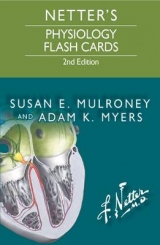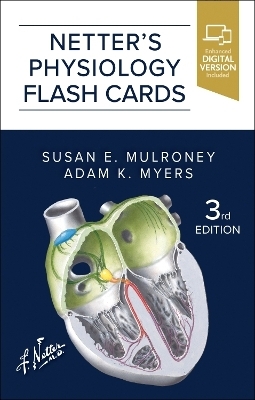
Netter's Physiology Flash Cards
Saunders
978-1-4160-4628-8 (ISBN)
- Titel erscheint in neuer Auflage
- Artikel merken
"Netter's Physiology Flash Cards" - the perfect resource for fast and fun reinforcement of key physiologic knowledge! This title includes 200 cards, beautifully designed in the Netter tradition, that offer the perfect streamlined review to help you learn essential facts and mathematical principles easily, efficiently, and at your own rate of study. Cards feature images and questions on the front, with answers and short commentary on the reverse.
Section 1: Cell Physiology 1-1.Membrane Proteins 1-2.Body Fluid Compartments 1-3.Measurement of fluid compartments 1-4.Starling forces across the capillary wall 1-5.Fluid Balance 1-6.Cellular Transport I: Active Transport 1-7.Cellular Transport II: Gated channels 1-8.Cellular Transport III: Solute Movement 1-9.Cellular Transport IV: Vesicular Transport 1-10.Cellular Transport V: Water Channels 1-11.Signal Transduction I: Ca2+ 1-12.Signal Transduction II: G-Protein Coupled Receptors 1-13.Signal Transduction III: Receptor Tyrosine Kinase Pathway 1-14.Signal Transduction IV: Nuclear Protein Receptors Section 2: The Nervous System and Muscle 2-1.Nernst Potential 2-2.Resting Membrane Potential 2-3.Axonal Action Potential 2-4.Neurons 2-5.Axonal conduction 2-6.Morphology of Synapses 2-7.Chemical Synaptic Transmission 2-8.Structure of the Neuromuscular Junction 2-9.Sarcoplasmic Reticulum 2-10.Excitation-Contraction Coupling 2-11.Skeletal Muscle Contraction and Relaxation 2-12.Biochemical Mechanics of Muscle Contraction 2-13.Excitation-Contraction Coupling of Smooth Muscle 2-14.Cardiac Muscle Structure 2-15.Major parts of the Central Nervous System and the Vertebral Column 2-16.Major Functions of the Hypothalamus 2-17.Somatic Component of the Peripheral Nervous System 2-18.Skin and Cutaneous Receptors 2-19.Visual Receptors 2-20.Cochlear receptors 2-21.Vestibular Receptors 2-22.Taste Receptors 2-23.Olfactory Receptors 2-24.Muscle and Joint Receptors 2-25.Spinal Reflex Pathways for Stretch, Tendon Organ, and Flexor Withdrawal Reflexes 2-26.Corticospinal Tract 2-27.Functional Subdivisions of Cerebellum 2-28.General Characteristics of the Parasympathetic and Sympathetic Nervous Systems 2-29.Actions of the Autonomic Nervous System Section 3: Cardiovascular Physiology 3-1.Pressures in the Circulation 3-2.Distribution of Cardiac Output 3-3.Chambers of the Heart 3-4.Cardiac Conduction System 3-5.Action Potential of Sinoatrial (SA) Node Cells 3-6.Action Potential of Ventricular Myocytes 3-7.Arterial Pressure Wave 3-8.Pressures in the Cardiovascular System 3-9.Poiseuille's Law 3-10.Poiseuille's Law II 3-11.Cross-Sectional Area (A) and Flow Velocity (V) 3-12.Laminar and Tubulent Flow 3-13.Wall Tension 3-14.Cardiac Cycle: Atrial Pressure Curve 3-15.Cardiac Cycle: Valve Opening and Closure 3-16.Cardiac Cycle: The Electrocardiogram 3-17.Autonomic Neurotransmitters and the Cardiovascular System 3-18.Baroreceptor Reflex 3-19.Cardiac Function Curve 3-20.Force-Velocity Relationship 3-21.Pressure-Volume Relationship 3-22.Cardiac Function and Vascular Function Curves I 3-23.Cardiac Function and Vascular Function Curves II 3-24.Vascular Wall 3-25.Microcirculation 3-26.Lymphatic Flow 3-27.Local Regulation of Blood Flow 3-28.Renin-Angiotensin-Aldosterone System 3-29.Coronary Blood Flow 3-30.Fetal Circulation Section 4: Respiratory Physiology 4-1.Pressures in the Pulmonary Circulation 4-2.Pulmonary Artery Pressure and Pulmonary Vascular Resistance 4-3.Lung Volume and Pulmonary Vascular Resistance 4-4.Chemical and Humoral Control of Pulmonary Vascular Resistance 4-5.Intrapulmonary Airways 4-6.Ultrastructure of Airways 4-7.Lung Volumes 4-8.Respiratory Muscles 4-9.Partial Pressure of Gases in the Atmosphere 4-10.Partial Pressure of Oxygen and Carbon Dioxide in Inspired Air, Alveolar Air and Blood 4-11.Alveolar Gas Equation 4-12.Distribution of Pulmonary Blood Flow 4-13.Ventilation-Perfusion Relationships 4-14.Pressure-Volume Relationships of Respiratory System 4-15.Pulmonary Compliance 4-16.Surface Forces in the Lung 4-17.Airway Flow I 4-18.Airway Flow II 4-19.Expiratory Flow-Volume Relationship 4-20.Lung Disease I 4-21.Lung Disease II 4-22.Oxyhemoglobin Dissociation Curve I 4-23.Oxyhemoglobin Dissociation Curve II 4-24.Oxyhemoglobin Dissociation Curve III 4-25.Oxyhemoglobin Dissociation Curve IV 4-26.Carbon Dioxide Transport I 4-27.Carbon Dioxide Transport II 4-28.Role of Lungs in pH Balance 4-29.Control of Respiration 4-30.Respiratory Response to Exercise Section 5: Renal Physiology 5-1.Anatomy of the Kidney 5-2.Anatomy of the Kidney: The Nephron 5-3.Anatomy of the Kidney: Nephron Populations 5-4.Anatomy of the Kidney: The Glomerulus 5-5.Glomerular Filtration 5-6.Renal Handling of Substances: Calculations 5-7.Regulation of Renal Hemodynamics I 5-8.Regulation of Renal Hemodynamics II 5-9.General Solute Handling Through the Nephron I 5-10.General Solute Handling Through the Nephron II 5-11.General Solute Handling Through the Nephron III 5-12.General Solute Handling Through the Nephron IV 5-13.Nephron Sites of Sodium Handling 5-14.Hormonal Control of Renal Sodium Reabsorption 5-15.Reabsorption of Glucose I 5-16.Reabsorption of Glucose II 5-17.Renal Bicarbonate Handling 5-18.Renal Solute Handling: Potassium Handling I 5-19.Renal Solute Handling: Potassium Handling II 5-20.Renal Calcium Handling 5-21.Renal Phosphate Handling 5-22.Interstitial Concentration Gradient 5-23.Urine Concentration 5-24.Renin-Angiotensin-Aldosterone System (RAAS) I 5-25.Renin-Angiotensin-Aldosterone System (RAAS) II 5-26.Renin-Angiotensin-Aldosterone System (RAAS) III 5-27.Renin-Angiotensin-Aldosterone System (RAAS) IV 5-28.Volume Regulation I: Integrative Response to Volume Contraction 5-29.Volume Regulation II: Integrated Response to Volume Expansion 5-30.Acid-Base I: Renal Mechanisms of Acid-Base Homeostasis 5-31.Acid-Base II: Ammonia Synthesis 5-32.Acid-Base III: Net Acid Excretion (NAE) 5-33.Acid-Base IV: Titratable Acids 5-34.Acid-Base V: Acidosis and Anion Gap 5-35.Acid-Base Imbalances I 5-36.Acid-Base Imbalances II Section 6: Gastrointestinal Physiology 6-1.GI Anatomy: Overview of the GI Tract 6-2.GI Anatomy: Enteric Nervous System 6-3.GI Anatomy: The Portal System 6-4.The Thirst Response 6-5.Autonomic Nerves in the GI Tract 6-6.Peristalsis 6-7.Electrical Potentials in the GI Tract 6-8.Control of Gastric Emptying 6-9.Motility in the Colon 6-10.General Gastrointestinal Reflexes 6-11.Saliva 6-12.Gastric Pit Cells 6-13.Parietal Cell Production of Acid 6-14.Stimulation of Gastric Acid Secretion 6-15.GI Anatomy: Ductal System for Liver, Gallbladder and Pancreatic Secretions 6-16.Major GI hormones 6-17.Anatomy of the Liver 6-18.Liver Metabolism 6-19.Bile Production and Secretion 6-20.Portal Hypertension 6-21.Stimulation of Digestive Enzymes 6-22.Carbohydrate Digestion 6-23.Carbohydrate Absorption 6-24.Protein Digestion 6-25.Protein Absorption 6-26.Lipid Digestion I: Enzymes 6-27.Lipid Digestion II: Bile and Micelle Formation 6-28.Intracellular Lipid Processing 6-29.Fluid and Electrolyte Absorption 6-30.Calcium Absorption 6-31.Vitamin B12 Absorption Section 7: Endocrine Physiology 7-1.General Principles of Hormone Binding I 7-2.General Principles of Hormone Binding II 7-3.Hypothalamus and Pituitary: Anatomy 7-4.Pituitary Gland: Anterior Pituitary Hormones 7-5.Pituitary Hormones: General Actions 7-6.Pituitary Hormones: Growth Hormone Feedback Systems 7-7.Pituitary Hormones: Male Reproductive Hormones 7-8.Pituitary Hormones: Female Reproductive Hormones 7-9.Thyroid Hormone: Control of Thyroid Hormone Synthesis 7-10.Thyroid Hormone: Synthesis 7-11.Thyroid Hormone: Intracellular Actions 7-12.Thyroid Hormone: General Systemic Actions 7-13.Adrenal Hormones: Adrenal Gland Structure 7-14.Adrenal Hormones: Adrenal Cortical Hormones 7-15.The Endocrine Pancreas: major hormones 7-16.The Endocrine Pancreas: Insulin secretion 7-17.The Endocrine Pancreas: Actions of Insulin 7-18.The Endocrine Pancreas: Actions of Glucagon 7-19.Calcium-Regulating Hormones: Vitamin D 7-20.Calcium-Regulating Hormones: Actions of Vitamin D 7-21.Calcium-Regulating Hormones: Actions of Parathyroid Hormone 7-22.Calcium-Regulating Hormones: Altered Parathyroid Secretion 7-23.Reproductive Hormones: Development of Genital Sex 7-24.Reproductive Hormones: Puberty and Secondary Sex Characteristics 7-25.Reproductive Hormones: Hormonal Regulation of the Menstrual Cycle 7-26.Reproductive Hormones: Feedback Regulation of the Menstrual Cycle 7-27.Reproductive Hormones: The Testes and Spermatogenesis 7-28.Reproductive Hormones: Control of Testicular Function
| Erscheint lt. Verlag | 1.9.2009 |
|---|---|
| Reihe/Serie | Netter Basic Science |
| Zusatzinfo | Approx. 200 illustrations |
| Verlagsort | Philadelphia |
| Sprache | englisch |
| Maße | 102 x 152 mm |
| Themenwelt | Studium ► 1. Studienabschnitt (Vorklinik) ► Physiologie |
| ISBN-10 | 1-4160-4628-3 / 1416046283 |
| ISBN-13 | 978-1-4160-4628-8 / 9781416046288 |
| Zustand | Neuware |
| Informationen gemäß Produktsicherheitsverordnung (GPSR) | |
| Haben Sie eine Frage zum Produkt? |
aus dem Bereich



